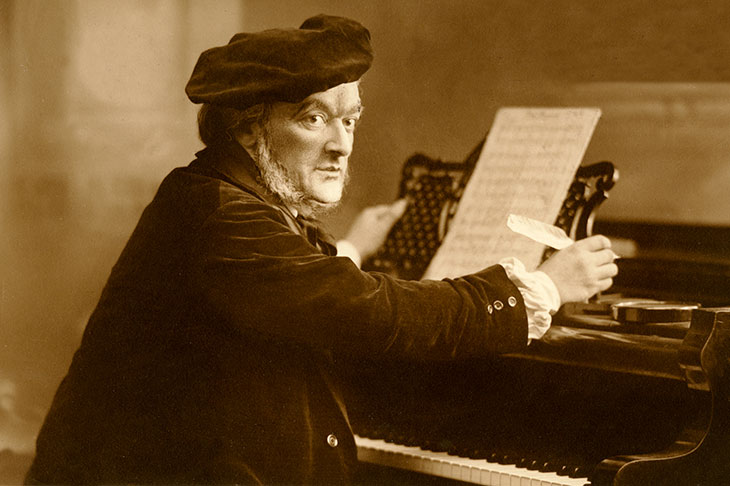In the early 1920s a French businessman, Leon Bel, was looking for a name for his new brand of processed cheese. He remembered seeing a meat wagon on the World War One battlefields with the sardonic name ‘La Wachkyrie’. Like the Valkyries in Wagner, it brought solace to fallen soldiers in the field. Bel thought it would do very well, and gave his cheese the same name in a more orthodox spelling. La Vache Qui Rit (the Laughing Cow) is still very popular today.
Reading this completely unsuspected story of a trademark in Alex Ross’s book, I wondered with some astonishment at this world. A businessman looking for a striking name for a mass-market product hits on a joke about the title of a five-hour German music drama written 70 years earlier — and it succeeds. His market knows what he’s talking about.
Wagner gripped the communal mind for decades after his death in 1883, and he’s not done with us yet. Ross has written a book about Wagner’s consequences with a striking omission — what he did with music, and what he did to music. Wagner was, above all, a composer. The power of his musical invention is the reason why he is still in our lives. All other mythical dramatists, contrivers of theatrical spectacle, political theorists and grubby purveyors of national and racial theories from his time have disappeared, as Wagner, without his music, would certainly have disappeared.
Nevertheless, it is possible, as Ross has found, to write a very long book about his influence which has almost nothing to say about the music itself, and which doesn’t find it necessary to talk about the music that was shaped by him. Ross quotes an American mythographer saying that ‘Wagner’s two great successors are James Joyce and Thomas Mann,’ rather than, for instance, Debussy and Schoenberg. It is an eccentric approach, but entirely possible.
Many of the best creative minds of the time were immediately engaged by Wagner’s endeavor. Between the 1850 Weimar premiere of Lohengrin and the 1865 premiere of Tristan und Isolde Wagner had written four full-length operas and two acts of another. Concert performances had built up interest across Europe. By the time of the construction of the theater in Bayreuth solely for the performance of his work, and the first production there in 1876 of the full cycle of the Ring of the Nibelung, Wagner was probably the object of more feverish intellectual speculation than any artist in the world. One more music drama followed, Parsifal, expressly written for the unique Bayreuth design and acoustics, and confined to performances there until the 20th century.
The division between Wagner and Wagnerism was already apparent in the composer’s lifetime. In many of the best houses, even today, you can be ticked off for applauding after the first act of Parsifal, rather than filing out in sacramentally silent awe. The tradition goes back to the original performances; but it’s recorded that the audience member who was indignantly hissed for yelling Brave at the Flower Maidens turned out, when the lights were raised, to be Wagner himself. Once he was dead, and control passed to his terrifying widow Cosima, all bets were off.
Ross does a good and very full job in tracing the obsession of different times and places, and the intellectual flavor each wave took— the young George Bernard Shaw’s take on the Ring as socialist allegory, or the mystical withdrawal into Teutonic obscurity of French poets, from Baudelaire to Mallarmé and onwards (oddly, Ross doesn’t mention the wonderfully self-named poet Tristan Klingsor). There are passages about the cult of Wagner in Japan (surprisingly early — children’s guides to Wagner were being published in 1928) and about the philosophers’ Wagner. In my view, you’d be about as likely to buy a ticket for Götterdämmerung on the basis of its philosophical content as you would be to base your plans for international world domination on a round of Risk. But Wagner was deep in Schopenhauer, and Nietzsche was torn in two by his fascination with, then rejection of, the composer. Philosophers have continued to gnaw at his work.
As time went on, Wagner proved more and more prophetic. The theater at Bayreuth is astonishingly reminiscent of a cinema, with its total dark, invisible source of sound and apparently floating stage picture. Film-makers have gone on stealing from him, from direct allusion to probably unconscious theft from what is now common mythical currency. Tolkien took the idea of the ring from Wagner — it has no other source — and Parsifal stilling Klingsor’s thrown spear in mid-air turns up at the climax of The Matrix.
The question at the center of this study, of course, is Wagner’s responsibility for, and relationship with, Hitler. There is no doubt that Wagner, like many 19th-century figures, was personally anti-Semitic in a more than casual way. There is also the point that Bayreuth was very happy to be used by Hitler as a venue for one of his festivals of Teutonic culture, just as Himmler turned Quedlinburg into a centre of hieratic pilgrimage. Wagner’s politics are complex, however, and went through a series of different stages. In the 1920s, German commentators, quite reasonably, regretted that the idealistic, revolutionary spirit of equality apparent in Wagner had been lost to a fascist faction of admirers.
The claim that there is anti-Semitism in the operas themselves runs up, in my view, against some awkward facts. First, there is no evidence that opera productions during the Third Reich ever depicted the characters Mime and Beckmesser as Jewish. Hitler never made any kind of comment on Wagner’s attitude to the Jews. Most of the Nazis detested Wagner, and even denounced the compassionate conclusion of Parsifal. There is nothing in any of the operas’ music which unarguably indicates that a character might be Jewish, though musical conventions were well established — the vile caricature in Mussorgsky’s Pictures at an Exhibition predates the Ring.
Ross is very conscious of the complexity of these questions, and how they have become more complicated with the passage of time. His omission of much consideration of Wagner’s music has the curious effect of making those who were obsessed by him sound somewhat deranged. This, however, is not always inappropriate, and much of the story is inevitably of gross misuse on both sides. Thomas Mann wrote, very truly, of ‘the malicious abuse to which this great object somewhat lends itself’. That goes both for the Bayreuth audiences in the 1930s, rising to salute Hitler in the last scenes of Die Meistersinger, and the conspicuously non-musical polemicists who have since attempted to erase Wagner from concert programs on the unproven and implausible claim that his music was played daily in the concentration camps.
(It was more likely to have been Schubert.)
[special_offer]
Ross’s book is excellent, and extraordinarily thorough. Though one occasionally misses a musically literate person saying something intelligent about Wagner — Debussy on the orchestration of Parsifal appearing illuminated from behind, or Berlioz saying that the Tristan prelude was nothing but appoggiaturas — there are plenty of books about that. Leaving the music to one side, Ross’s is a very thorough account of apparent delusion in search of a fugitive meaning.
In the end, one can only say that what Wagner created in pure sound is of such power that it will always survive the worst of its creator’s character, and the characters of the worst of his admirers. What it means was perhaps best accounted for by, of all people, the novelist Philip K. Dick:
‘
Parsifal is one of those corkscrew artifacts of culture in which you get the subjective sense that you’ve learned something from it, something valuable or even priceless; but on closer inspection you suddenly begin to scratch your head and say “Wait a minute. This makes no sense.”’
It might be a description of all of the greatest art, and in the end the message, over which posterity labored so hard, is secondary to darkness falling in a room in northern Bavaria; silence; from the depths, the single note of A flat in unison from wind and strings. It starts.
This article was originally published in The Spectator’s UK magazine. Subscribe to the US edition here.

























